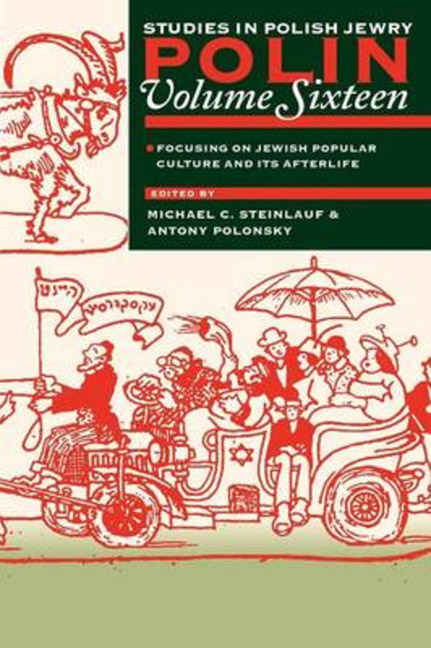Book contents
- Frontmatter
- Dedication
- Editors and Advisers
- Preface
- Polin
- Polin: Studies in Polish Jewry
- Contents
- Note on Place Names
- Note on Transliteration
- PART I JEWISH POPULAR CULTURE IN POLAND AND ITS AFTERLIFE
- IN PRE-WAR POLAND
- AFTERLIFE
- From ‘Madagaskar’ to Sachsenhausen: Singing about ‘Race’ in a Nazi Camp
- The Badkhn in Contemporary Hasidic Society: Social, Historical, and Musical Observations
- Transmigrations: Wolf Krakowski's Yiddish Worldbeat in its Socio-Musical Context
- ‘The Time of Vishniac’: Photographs of Pre-War East European Jewry in Post-War Contexts
- Repopulating Jewish Poland—in Wood
- The Kraków Jewish Culture Festival
- PART II DOCUMENTS
- PART III NEW VIEWS
- PART IV REVIEWS
- REVIEW ESSAYS
- BOOK REVIEWS
- CORRESPONDENCE
- OBITUARIES
- Notes on the Contributors
- Glossary
- Index
Repopulating Jewish Poland—in Wood
from AFTERLIFE
- Frontmatter
- Dedication
- Editors and Advisers
- Preface
- Polin
- Polin: Studies in Polish Jewry
- Contents
- Note on Place Names
- Note on Transliteration
- PART I JEWISH POPULAR CULTURE IN POLAND AND ITS AFTERLIFE
- IN PRE-WAR POLAND
- AFTERLIFE
- From ‘Madagaskar’ to Sachsenhausen: Singing about ‘Race’ in a Nazi Camp
- The Badkhn in Contemporary Hasidic Society: Social, Historical, and Musical Observations
- Transmigrations: Wolf Krakowski's Yiddish Worldbeat in its Socio-Musical Context
- ‘The Time of Vishniac’: Photographs of Pre-War East European Jewry in Post-War Contexts
- Repopulating Jewish Poland—in Wood
- The Kraków Jewish Culture Festival
- PART II DOCUMENTS
- PART III NEW VIEWS
- PART IV REVIEWS
- REVIEW ESSAYS
- BOOK REVIEWS
- CORRESPONDENCE
- OBITUARIES
- Notes on the Contributors
- Glossary
- Index
Summary
Among the many historical sites which Poland must unearth as it comes to terms with itself and learns to situate itself with respect to its neighboring ‘others,’ one in particular seems to me to be extremely promising and central—the interaction of Jewish and Polish memory.
DIANA PINTOWhat was done to the Jews before Polish eyes is an injury not only for the victims, but also for the witnesses.
HENRYK GRYNBERGOne doesn't struggle with ghosts; one placates them and lures them back.
RUTH GAYJÓZEF REGUŁA broods over a vision he had in the early 1960s. He grows animated.
A path led to a wooden fence, and a man sat there, in a black cloak and hat. It was just before dusk, the distance between us was about 20 metres. This man just looked at me. I felt paralysed, as if something unnatural were happening. I turned away, and then back. There was nobody. I had never seen anybody dressed like that. I was 10 years old.
Decades later Reguła understood he had seen a Jew.
Fragments of the pre-war Jewish world, physical and metaphysical, linger in the Polish landscape. Tombstone shards, crumbling synagogues, troubling or puzzling memories—in the absence of a Jewish community they are up for grabs. Few Poles shoulder the weight and ambivalence such remnants merit. But tourism and economic necessity have made some the accidental custodians of orphaned Jewishness in this post-Holocaust terrain. Keepers of cemetery keys; traders of scavenged ritual items; singers of Yiddish songs; taxi drivers who subsist by ferrying visitors around the death camp loop. Józef Reguła makes wooden Jews.
An elfin man in jeans and a button-down shirt, Reguła has invited me—a Jewish student from America—to his home. He is a sculptor and soft ice cream vendor in a small Polish town. Why, I want to know, is ‘Jewish culture’ circulating—celebrated, even—in almost Jewless, post-communist Poland? And, in particular, what does it mean that Poles carve tiny Jewish figurines—have carved them for over a century—and that these days Jewish tourists buy them? I set off in search of answers.
- Type
- Chapter
- Information
- Focusing on Jewish Popular Culture and Its Afterlife , pp. 335 - 356Publisher: Liverpool University PressPrint publication year: 2003

